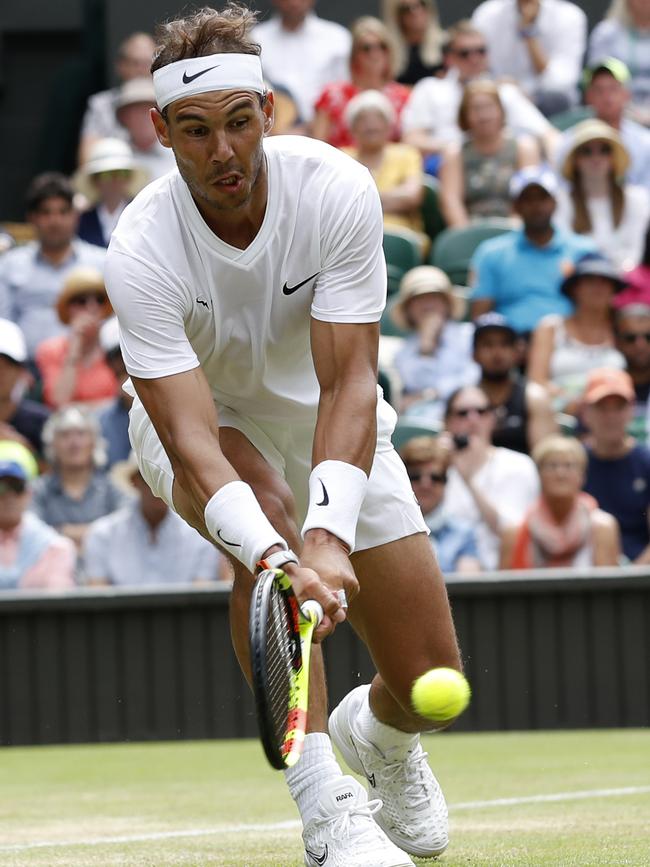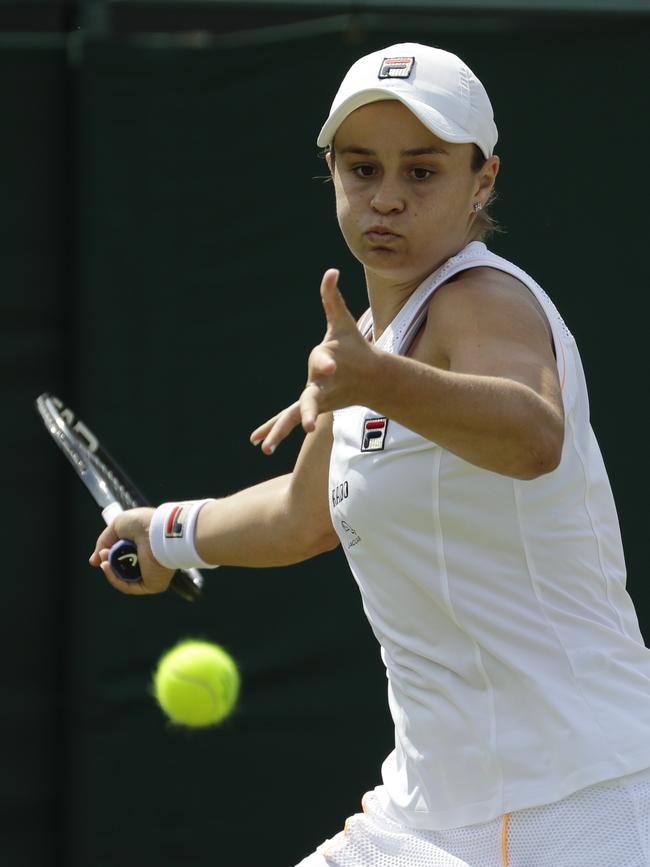Rafael Nadal: I’m a bit more than Barty and deserved top billing
Asked if Ash Barty’s match deserved Centre Court billing more than his, Nadal was blunt | WATCH
It was just about the first time all day that Rafael Nadal had found himself on the defensive. In the press conference room after a breezy fourth-round win that barely generated a sweat, Nadal was asked if his match deserved its Centre Court billing, and whether Wimbledon’s most prestigious court ought instead to have hosted the current women’s world No 1, Ashleigh Barty, who lost in three hard-fought sets to Alison Riske.
The Spaniard didn’t take a backward step. “I am the world No 2 and I won 18 grand slams,” he said. “In the world of tennis today, honestly, my feeling is today I am little bit more than Ashleigh Barty, even if Ashleigh Barty is the first player of the world and she already won in the French Open and she is playing unbelievably good.
“But we can’t create polemics every single day about decisions that they have to take. At the end of the day they have to make a decision.”
It was little wonder that he was in assertive mood, having subjected his opponent Joao Sousa to an evisceration, winning 6-2, 6-2, 6-2 in 105 entirely untroubled minutes. It was a measure of how routinely he negotiated the match that not a single one of the ten questions he was asked in his post-match press conference so much as mentioned Sousa. Instead, in addition to defending his own right to top billing, the two-time Wimbledon champion gamely held forth on topics such as paella, the golfer Jon Rahm, a fellow Spaniard, and Europe’s dominance of tennis. But then, that’s what Nadal in this sort of form does to you. He doesn’t so much beat you as render you an irrelevance.


The ultra slow-motion replays beloved of the BBC’s Wimbledon coverage recorded Nadal and the world No 69 Sousa in a variety of attitudes. For Nadal, they captured the vicious abundance of revolutions he imparts on the ball, the flexion of his biceps, the way his racket-head whips around after a particularly well-struck forehand with that savage tomahawk flourish.
For Sousa, the half-speed gaze of the TV director offered a less flattering encapsulation of his afternoon. Whether he was standing with his hands on his hips and his head thrown back to the heavens, exhaling with a Gallic flutter of the lips, or looking beseechingly at his box with his arms outstretched; the Portuguese went through the many gestures of a man who feels totally, utterly powerless.
Some have felt that Nadal has benefited from slightly slower courts this year. But Nadal was faintly insulted by the suggestion.
“Honestly, I don’t think the courts are playing slower today than in 2003 when I came the first time,” he said. “Personal feeling and personal opinion.”
Whatever the reason, the grass beneath Nadal’s feet is once again beginning to have the feel of a dominion that he bestrides rather than the slick, perilous surface that caused him such bother between 2012 and 2017, when he lost to such unheralded players as Lukas Rosol, Steve Darcis, Dustin Brown and Gilles Muller.
Against Sousa, the Spaniard played the sort of belligerent fuerza bruta tennis that has characterised his most dominant grand-slam displays. It is hard to appreciate, through the two-dimensional prism of a TV screen, the indomitable verticality of Nadal’s groundstrokes — the way his topspin forehand rears up to shoulder height and forces his opponent behind the baseline, like a back-pedalling postie trying to avoid a bounding, slobbering Great Dane.
Nadal’s serve has also been a key plank of his impressive Wimbledon campaign thus far. At this stage of the tournament, his record of 83 per cent points won behind his first serve places him behind only Ivo Karlovic, Milos Raonic, Sam Querrey and Kevin Anderson, all of whom are 6ft 5in or taller. It feels like a significant change: for much of this decade, Nadal was the one being cut down to size; now he is mixing it with the giants.
Nadal wasn’t the only contemporary great to enjoy an ominously serene passage to the quarter-finals. Roger Federer lost only five games in overcoming Matteo Berrettini, while Novak Djokovic did not face a single break point in his 6-3, 6-2, 6-3 victory over France’s Ugo Humbert.
Asked to explain the continuing dominance of the Big Three, Djokovic said: “Everything that we have achieved in our careers, we carry on to the court, [whereas] most of the players feel that pressure. For us it’s another match on the centre stage that we’ve experienced so many times. I think that’s one of the reasons why we feel comfortable being there and managing to play our best consistently.
“Dedication truly pays off. I guess each one of us top-three guys is different, but I think we share in common that we just love the game and we are very dedicated to it.”
For Nadal, a quarter-final against Querrey looms: a match that carries significant peril, given that the American has beaten Djokovic, Andy Murray, Dominic Thiem and Anderson at Wimbledon in recent years.
Beyond that, there is the tantalising prospect of a semi-final against Federer, which would be their first meeting at Wimbledon since the epic 2008 final. In the top half of the draw, Djokovic will play Belgium’s No 21 seed David Goffin for a place in the semi-finals.
The Times



To join the conversation, please log in. Don't have an account? Register
Join the conversation, you are commenting as Logout